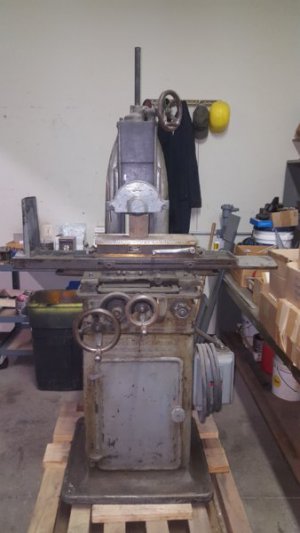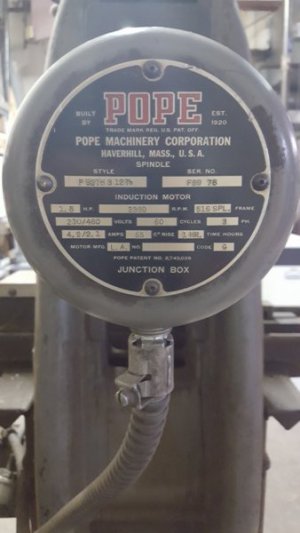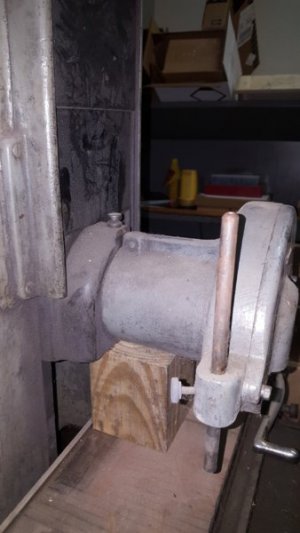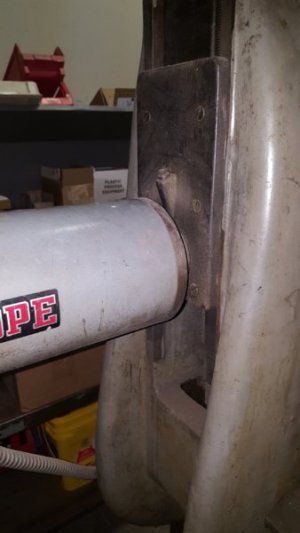- Joined
- Mar 27, 2018
- Messages
- 8
I need your help identifying what I have. It's an old B&S model 2 with a Pope P32 spindle assembly. Before that, this is my 1st post as a newbie to the forum. Nelson promotes communicating here so without rambling too much I'll give this short history of my life in the machining world. I was introduced to machining in the 80's after a 2yr college degree at Alfred State in New York majoring in Product & Machine Design. I worked for Eastman Kodak in Tool Engineering designing small sheet metal components for the instant camera line (I know this dates me I'll be 60 soon). After a year of sitting behind a drafting board (no computers back then) I'd had enough. I was hands on growing up working on motorcycles & cars. Sitting behind a desk 40hrs a week was not for me. A neighbor ran a precision machining dept. at a local company. My Dad told him my I was mechanically inclined & needed a job. So he hired me & this is where it all began. I apprenticed at Alliance Tool & Die in Rochester, NY in the Jig Bore Dept. I trained on Moore No.1 Jig Bore Mills then on to large Swiss SIP Hydroptic Jig Bore Mills. The dept. was made up of about 10 machinists most were well seasoned. I trained with an older German fellow who taught me a great deal. After I completed my 4yr apprenticeship I moved on to the horizontal machining dept. running a DeVlieg 48" mill. After hours I'd stay on my own time learn to run Bridgeport Mills & Engine Lathes with help from guys in the shop. It was a great environment to learn I really enjoyed working there. A couple years later Alliance was bought out by Jasco Corp. & I was eventually laid off with others in a 'restructuring plan'. Older equipment was being auctioned off at the time. I decided to start a small contract machining shop. I was still living at home & my dad let me use his 24'x32' barn to set up shop. From the auction I bought a Bridgeport J-Head added a DRO, a Boyar Shultz 6x12 surface grinder & a LeBlond 19" Servo Shift Engine Lathe. We trailered it all home in 2 trips on a U-Haul car trailer. After my dad & I rigged it all in I realized I needed 3-phase power to run (at the time I didn't know what 3ph was...I learned fast). I ordered an Arco 7-1/2hp Roto Phase & eventually had all the machines under power. It was slow starting the business but I picked up some local clients & ran for a year. I then met my bride of 30yrs, we were married, had a son, & I needed a full time job with benefits. I worked briefly for a couple of small machine shops eventually ending up at a Plastic Injection Molding Company as the lead maintenance technician. I eventually sold the lathe & grinder but kept the mill. I'm still in the plastics business & have a small shop in my garage. A few years ago I bought a 9" South Bend lathe currently disassembled awaiting a rebuild. I found a 16" South Bend lathe on Ebay later on at a price to good to pass up. Its complete & original, just an older machine. Needing to round out my shop I recently found a Brown & Sharpe Model 2 Surface Grinder for cheap.
Here's where I need help. I've read up on the B&S Model 2, 2L, 2LB. The machine I have is the power table & cross machine but is missing some of the drive components. I only need the grinder for tool sharpening & light grinding so lacking power feeds is no problem. It has the Pope 32 spindle drive. I've read this was an option from B&S back in the day but also a later retrofit on many machines. It looks like this grinder was a later retrofit. The machine base does not look like it ever had the lower drive motor running the spindle & power feeds via a flat belt. I assume this machine originally had the flat belt system driven from the spindle. My question is about the spindle lube system. I understand there were two types of spindle bearings, one an oil lubricated sleeve with bowl type oilers, the other sealed greased bearings. This machine has two oil ports on the spindle casting, one in front, one behind the column. The ports each have a pull-out plug just like the many other oiling ports for the table, shafts, etc. The machine has not been run for several years, the spindle rotates freely & feels tight. Should I install oilers in the two spindle ports, assuming this is a sleeve type spindle? Any ideas would be of great help. Attached are some pics of my machine. Thanks for tolerating my ramble above...I've been a machining 'nut' for 40 years, glad to be able to share my passion with all of you! Mike




Here's where I need help. I've read up on the B&S Model 2, 2L, 2LB. The machine I have is the power table & cross machine but is missing some of the drive components. I only need the grinder for tool sharpening & light grinding so lacking power feeds is no problem. It has the Pope 32 spindle drive. I've read this was an option from B&S back in the day but also a later retrofit on many machines. It looks like this grinder was a later retrofit. The machine base does not look like it ever had the lower drive motor running the spindle & power feeds via a flat belt. I assume this machine originally had the flat belt system driven from the spindle. My question is about the spindle lube system. I understand there were two types of spindle bearings, one an oil lubricated sleeve with bowl type oilers, the other sealed greased bearings. This machine has two oil ports on the spindle casting, one in front, one behind the column. The ports each have a pull-out plug just like the many other oiling ports for the table, shafts, etc. The machine has not been run for several years, the spindle rotates freely & feels tight. Should I install oilers in the two spindle ports, assuming this is a sleeve type spindle? Any ideas would be of great help. Attached are some pics of my machine. Thanks for tolerating my ramble above...I've been a machining 'nut' for 40 years, glad to be able to share my passion with all of you! Mike




Last edited:

